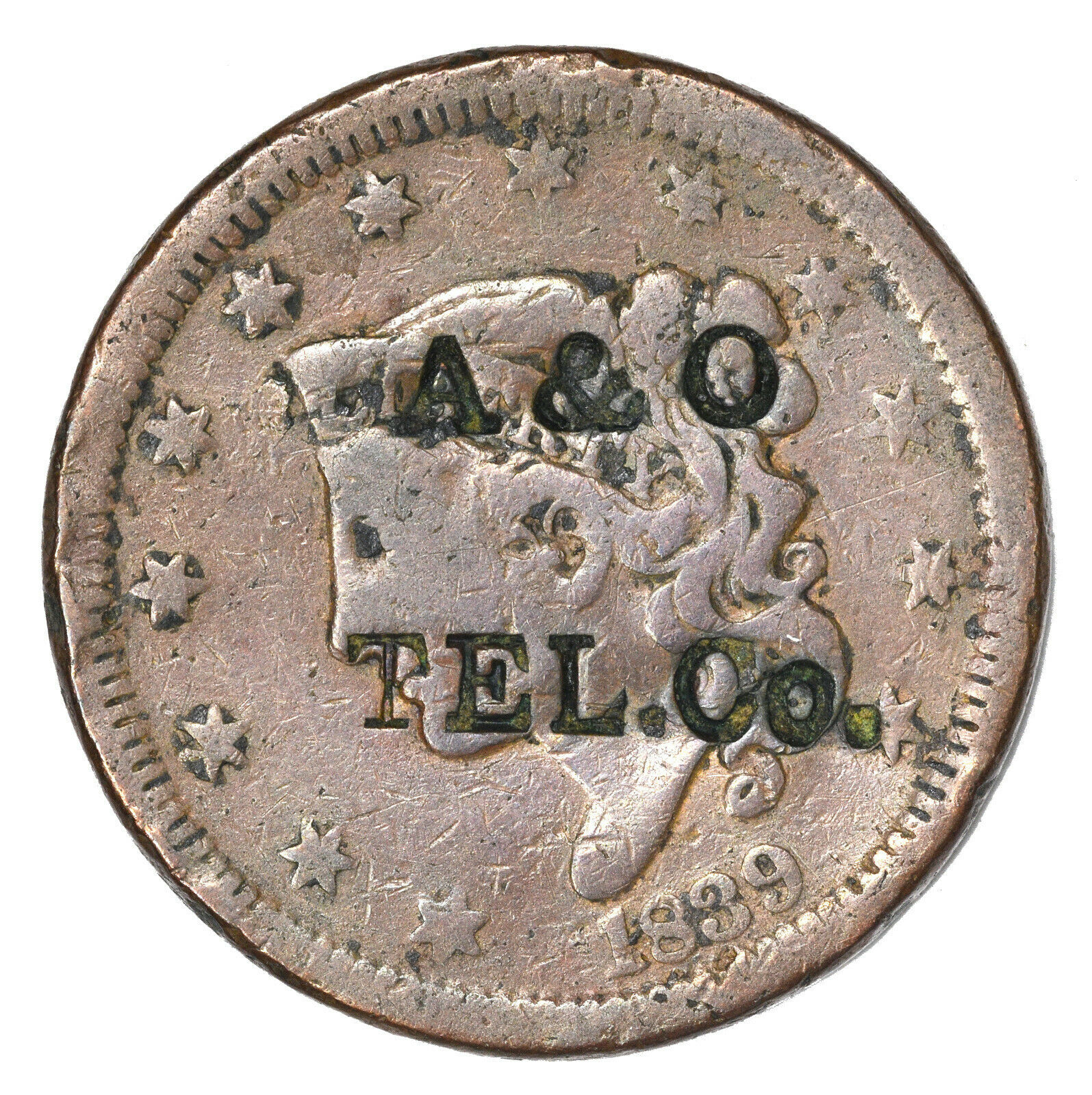-40%
1839 Large Cent, Counterstamp "A & O / TEL. Co" (Atlantic & Ohio Telegraph Co.)
$ 29.56
- Description
- Size Guide
Description
CHECK OUT MY OTHER EBAY LISTINGS!1839 U.S. Large Cent
Countermarked "A & O / TEL. Co."
Brunk A-15.
This is an issue of the Atlantic & Ohio Telegraph Company. This company operated in Pennsylvania.
Ex. Q. David Bowers collection.
Research Notes (very interesting!):
In 1832 Samuel F. B. Morse, assisted by Alfred Vail, conceived of the idea for an electro-mechanical telegraph, which he called the "Recording Telegraph." This commercial application of electricity was made tangible by their construction of a crude working model in 1835-36.
The telegraph was further refined by Morse, Vail, and a colleague, Leonard Gale, into working mechanical form in 1837. In this year Morse filed a caveat for it at the U.S. Patent Office.
In 1838 Morse perfected his sending and receiving code and organized a corporation, making Vail and Gale his partners.
In 1843 Morse received funds from Congress to set-up a demonstration line between Washington and Baltimore.
After an unsuccessful attempt at laying underground cables with Ezra Cornell, the inventor of a trench digger, Morse switched to the erection of telegraph poles and was more successful. (I can’t help but think that this incident caused us to have telephone poles for a century and a half, instead of underground lines....)
On May 24, 1844, Morse, in the U.S. Supreme Court Chambers in Washington, sent by telegraph the oft-quoted message to his colleague Vail in Baltimore, "What hath God wrought!"
The first commercial telegraph line was completed between Washington, D.C., and New York City in the spring of 1846.
By 1851 there were over fifty separate telegraph companies operating in the United States.
Between 1857 and 1861 several consolidations of telegraph companies took place in many areas of the country so that most of the telegraph interests of the United States had merged into six systems. These were the American Telegraph Company (covering the Atlantic and some Gulf states), The Western Union Telegraph Company (covering states North of the Ohio River and parts of Iowa, Kansas, Missouri, and Minnesota), the New York Albany and Buffalo Electro-Magnetic Telegraph Company (covering New York State), the Atlantic and Ohio Telegraph Company (covering Pennsylvania), the Illinois & Mississippi Telegraph Company (covering sections of Missouri, Iowa, and Illinois), and the New Orleans & Ohio Telegraph Company (covering the southern Mississippi Valley and the Southwest). All these companies worked together in a mutually friendly alliance, and other small companies cooperated with the six systems, particularly some on the West Coast.
The number of telegraph wire miles rose from 40 in 1846 to 2,000 in 1848 to 12,000 in 1850.
In 1845 O’Rielly, who used technology developed by the Scottish inventor Alexander Bain, strung a line from Lancaster to Harrisburg (Pa) – the start of the grandly named Atlantic & Ohio Telegraph Company.
Emma Hunter became a telegraph operator for the Atlantic & Ohio Telegraph Company in West Chester in 1851. Her initial salary was per year. She became the first “electronic commuter” in 1851 – (she worked out of her parlor). Emma learned telegraphy from Uriah H. Painter in West Chester and began to operate in 1851. She was considered to be an expert operator – “Emma of S” was her “sine”. Her telegraph office and her mother’s stationery store moved to the Pennsylvania Railroad depot in 1857. Managing a telegraph office is a little-studied aspect of business management by women in the 19th century. Emma was a telegrapher at West Chester during the Civil War; she sent many war-related messages.
1845: Few entrepreneurs proved more [...] than Henry O'Rielly, who in 1845 strung a line across the sparsely populated Pennsylvania Alleghenies and dubbed it the Atlantic & Ohio Telegraph Company.
Mar. 17, 1849: Canal Commissioners authorize Atlantic & Ohio Telegraph Company to string wire along the Main Line between Harrisburg and Pittsburgh.
Mar. 21, 1849: PRR Board authorizes James Kennedy Moorhead and William H. Parmentier of Atlantic & Ohio Telegraph Company to build telegraph line along the PRR.
Sep. 11, 1849: Canal Commissioners authorize Atlantic & Ohio Telegraph Company to string wire along Main Line between Philadelphia and Harrisburg.
Nov. 21, 1849: PRR contracts with Atlantic & Ohio Telegraph Company to build line in return for doing all PRR telegraph business free.
1849: At age 13, Robert Pitcairn gets first job as a telegraph messenger for the Atlantic & Ohio Telegraph Company in Pittsburgh; other young employees include David McCargo, Henry W. Oliver, and ANDREW CARNEGIE.
Jan. 1, 1855: PRR opens its own telegraph line between Pittsburgh and Altoona, replacing the use of lines of Atlantic & Ohio Telegraph Company.
I ALWAYS COMBINE SHIPPING ON MULTIPLE LOTS.
BIDDERS LOCATED OUTSIDE THE USA -----> PLEASE WAIT FOR AN INVOICE BEFORE PAYING.











